Phylum Chordata Rank Species | Family Alcidae Higher classification Cepphus Order Shorebirds | |
Similar Bird, Rhinoceros auklet, Cepphus, Pelagic cormorant, Auk | ||
Pigeon guillemot
The pigeon guillemot (Cepphus columba) is a species of bird in the auk family, Alcidae. It is endemic to the Pacific Ocean. It closely resembles the other members of the genus Cepphus, particularly the black guillemot, which is slightly smaller and lacks dark wing lines.
Contents
- Pigeon guillemot
- Taxonomy and nomenclature
- Description
- Distribution
- Breeding
- Feeding
- Predators and parasites
- Status
- References
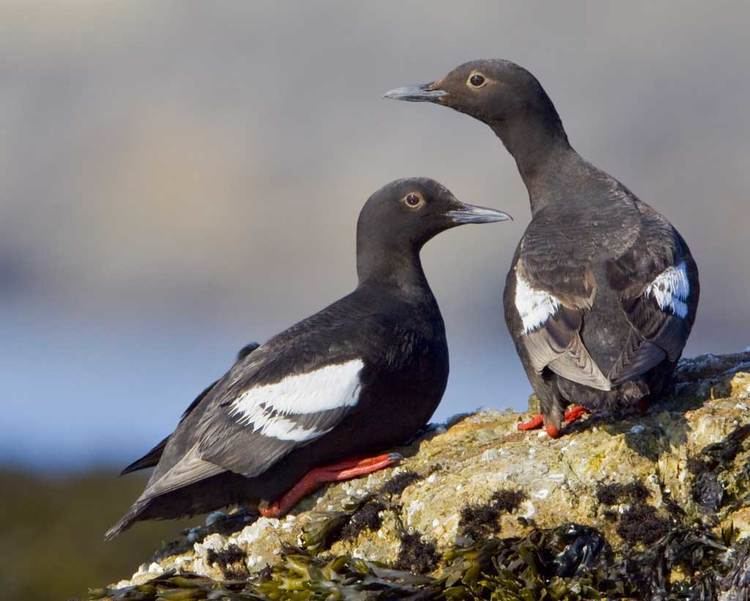
The pigeon guillemot is considered to be a least concern species by the International Union for Conservation of Nature (IUCN).
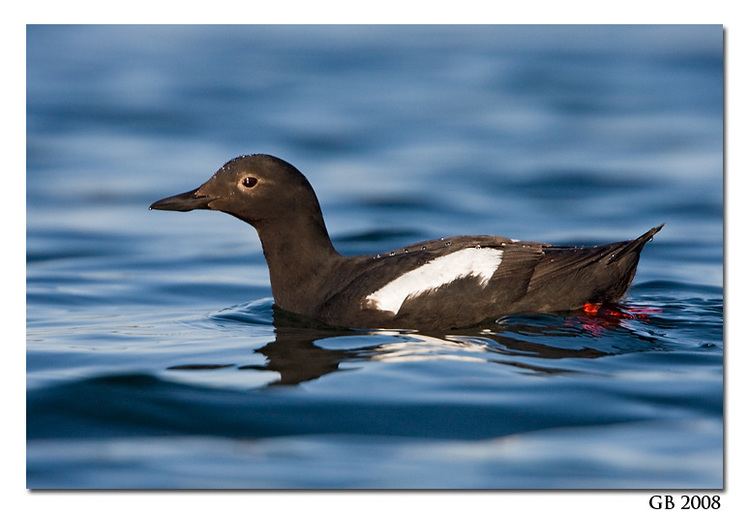
Pigeon guillemot
Taxonomy and nomenclature
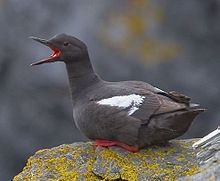
The pigeon guillemot is one of three species of auk in the genus Cepphus, the other two being the black guillemot of the Atlantic Ocean and the spectacled guillemot from the Eastern Pacific. The genus Cepphus is most closely related to the murrelets from the genus Synthliboramphus. Within the genus, the pigeon guillemot and spectacled guillemot are sister species, and the black guillemot is basal within the genus. The pigeon guillemot and the black guillemot form a superspecies.
There are five listed subspecies of the pigeon guillemot:
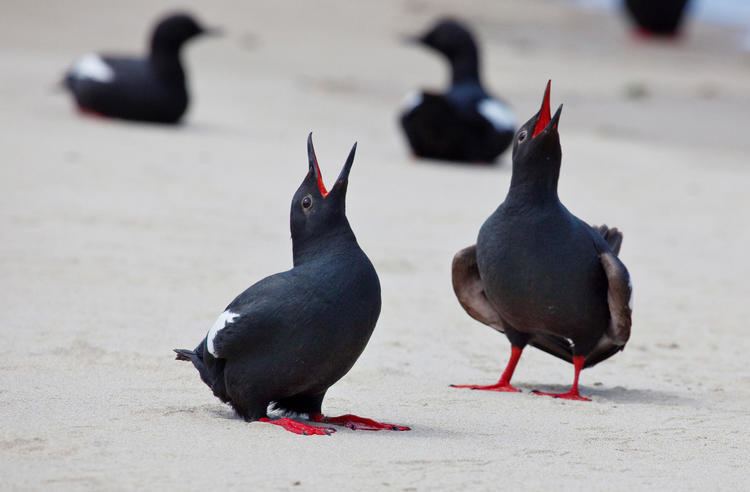
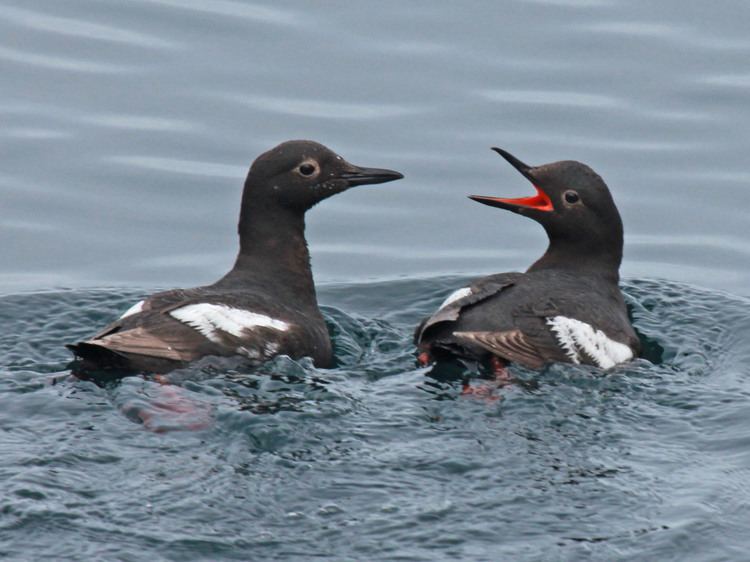
In the binomial name, the genus, Cepphus, is derived from the Greek kepphos, meaning "pale unknown waterbird, later variously identified". The specific epithet, columba, is derived both from the Icelandic klumba, meaning "auk", and the Latin columba, meaning "pigeon". Snowi is dedicated to Captain Henry James Snow, a British seaman and hunter. The name of the subspecies kaiurka is derived from the Russian kachurka, meaning "petrel". Adiantus is derived from the Greek adiantos, "unwetted". The trinomial epithet of the subspecies C. c. eureka is derived from the motto of the state of California, which itself is derived from the Greek heurēka, meaning "I have found it".
Description
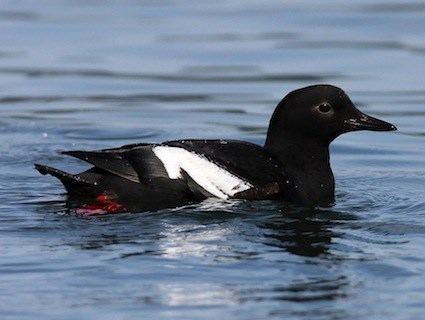
The pigeon guillemot is a medium-sized auk, 30 to 37 centimetres (12 to 15 in) in length and weighing 450 to 550 grams (16 to 19 oz). The adult bird has a black body with a white wing patch broken by a black wedge, and red legs and feet. The bill is long and black with a red mouth. In winter, the upperparts are mottled grey and black, with the underparts being white. It walks well and habitually has an upright posture. The differences between the subspecies are based on body measurements such as the culmen and wing length. These are larger in southern subspecies and smaller further north. The amount of white on the outer primaries and underwing coverts increases in northern subspecies, except for Cepphus columba snowi, where the white is reduced or entirely absent. The juvenile pigeon guillemot has faint white streaking, with brownish black feathers. Its legs are a gray-orange colour.
Distribution
The pigeon guillemot ranges across the Northern Pacific, from the Kuril Islands and the Kamchatka Peninsula in Siberia to coasts in western North America from Alaska to California. This bird's wintering range is more restricted than its breeding season range, with the pigeon guillemot usually wintering at sea or on the coasts, from the Pribilof and Aleutian Islands to Hokkaido and southern California. In Alaska, it will generally migrate south to more sheltered inshore waters, and in California, it will usually migrate north. It generally will return to its natal colony, the colony where it was born, to breed.
This bird's breeding habitats are rocky shores, cliffs, and islands close to shallow water less than 50 m (160 ft) deep. In the winter it forages along rocky coasts, often in sheltered coves. In the Bering Sea and Alaska it will feed in openings in ice sheets.
Breeding
The pigeon guillemot usually lays its eggs in rocky cavities near water, but will often nest in any available cavity, including caves, disused burrows of other seabirds, and even old bomb casings. It is noted that pigeon guillemots do not inhabit nests with gull eggs, specifically those of the western gull. This pigeon usually retains its nest site, meaning that nest sites are usually used multiple times, although it will usually switch where it nests if its mate does not return to breed. The nests are found at a wide range of heights, from about 1 to 55 metres (3.3 to 180.4 ft).
Foreign eggs in this pigeon's nest are generally removed. Nest competition with Cassin's auklet is occasional, with the pigeon guillemot almost always just removing the eggs, and rarely pithing before removal.
This pigeon nests at a variety of densities, ranging from a single individual to dense colonies. The nesting density is generally not affected by predation, although on a very local scale, nesting closer to neighbors has a slight advantage. During the night, the pigeon guillemot is not, except when incubating, found at the colony. It usually arrives in the morning, during high tide, with counts decreasing as the day goes on. The number of this pigeon is affected by the tide, with more appearing when the tide is higher and less when the tide is lower. The counts vary the most before laying, while they are relatively stable during incubation and egg laying.
Usually arriving at its breeding range 40 to 50 days before laying starts, the pigeon guillemot breeds from May to September. During this time, it usually lays a clutch of one or two eggs. The eggs have grey and brown blotches near the larger end of the egg and range in colour from creamy to pale blue-green. They usually measure 61.2 by 41.0 millimetres (2.41 in × 1.61 in), with eggs getting longer as the breeding season progresses. Incubated by both sexes, the eggs usually hatch after 26 to 32 days. The chicks will usually fledge 34 to 42 days after hatching, although chicks have been known to fledge anywhere from 29 to 54 days after hatching. Generally, the adult will leave the colony it is in after the chicks fledge. The chicks do not breed until at least three years after hatching, with most first breeding at four years of age.
Feeding
This pigeon forages by itself or in small groups, diving underwater for food, usually close to shore and within 1 kilometre (0.62 mi) of the colony. It forages at depths from 6 to 45 metres (20 to 148 ft), but it prefers to forage at depths between 15 and 20 metres (49 and 66 ft). The dives usually average 87 seconds, with an intermission between dives lasting around 98 seconds.
It feeds on benthic prey, or prey at the lowest level in a body of water. It mainly eats fish and other aquatic animals, particularly sculpins, sandfish, cod, capelin, and crabs. The chick's diet varies slightly, with more fish than invertebrates, particularly rockfish. Specialization in a pigeon guillemot when foraging for its chicks generally results in greater reproductive success, with a high-lipid diet allowing for more growth.
The adult pigeon guillemot requires about 20% of its own weight, or 90 grams (3.2 oz) of food each day. It doubles its rate of fishing when feeding the nestlings. As the nestlings get older, they are fed more, until 11 days after hatching, when the food generally levels out. The food they get, although, starts to decrease about 30 days after hatching.
Predators and parasites
Avian predation is the most common natural way that eggs of the pigeon guillemot are lost. One avian predator is the crow, a common predator of this pigeon's eggs and chicks. Raccoons are also common predators, preying on eggs, chicks, and adults.
This bird, especially its chicks, are vulnerable to Aspergillus fumigatus, a fungal disease, while in captivity. It is also vulnerable to the cestode Alcataenia campylacantha.
Status
The pigeon guillemot is considered to be a least concern species by the IUCN. This is due to multiple factors, including its large population, estimated at 470,000 individuals, its stable population, and its large range, as this bird is thought to occur over a range of 15,400,000 square kilometres (5,950,000 sq mi). Climate change has a negative effect on this bird, with reproductive performance decreasing with increased temperatures.
